
Glass Blowing for Vacuum Devices
Getting Started
Safety
Like most things on this web site, glass blowing can be dangerous. The glass has to be
heated to over 600C and can therefore cause serious burns and can start fires. The
hazards of flammable gas are obvious and Butane/Propane cylinders must never be heated
above 50C. Cuts are also a risk when working with glass.A glass tube must never be put
in the mouth unless the end has been rounded. How this is done is explained in the
section on cutting glass tubes. For protection, I wear thick jeans. These can give some
limited protection if a hot piece of glass lands in my lap. Goggles are probably a
good idea too. Unfortunately, thick gloves are not really practical because one requires
good control over the work piece. Glass stays hot for a long time.
Care has to be taken to check that it has cooled sufficiently before touching it or
putting it in the mouth. A minor burn can be treated by running cool water over it for
ten minutes, but the work area must be made safe first. The glass which caused the burn
could still be hot enough to start a fire. The floor around the work area tends to
end up with small sharp bits of glass on it. Children and pets must be kept away and
the area cleaned up frequently.
Glass Tubing
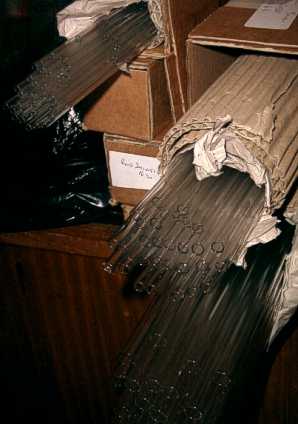 I decided to start learning using soda-lime glass because it is cheap and has a lower
softening temperature than borosilicate glass. Common soda-lime glass softens at around
600C. I have learned that soda-lime glass has a high expansion co-efficient, which makes
if very susceptible to cracking. However, with a little care and hand annealing, much
can be accomplished with it. Lead glass is easier to work with than soda-lime glass,
but is now virtually unavailable in the UK.It is best to buy new glass because it can
degrade in storage and become harder to work with.
I decided to start learning using soda-lime glass because it is cheap and has a lower
softening temperature than borosilicate glass. Common soda-lime glass softens at around
600C. I have learned that soda-lime glass has a high expansion co-efficient, which makes
if very susceptible to cracking. However, with a little care and hand annealing, much
can be accomplished with it. Lead glass is easier to work with than soda-lime glass,
but is now virtually unavailable in the UK.It is best to buy new glass because it can
degrade in storage and become harder to work with.
I purchased glass tubing from
Fisher Scientific. I have found that 8mm and 12mm diameter thin wall tubes are useful
sizes to start with. I purchased fifty 0.5m long tubes of each size. The 8mm diameter
tubes have a wall thickness of 0.8mm while the 12mm diameter tubes have a wall
thickness of 1mm. I also bought 5mm and 8mm diameter rods and 6mm diameter tubes.
These have been less useful so far, but I have used small ammounts of the 5mm rod.
There are many different types of glass, each with different characteristics. It is very
important to know what type of glass is being worked and what characteristics it has.
Although it is possible to join some different glass types together, it is best avoided.
It is best to work with new glass, all of the same composition and preferably all from the
same manufacturer.
Note added September 2009: Fisher only sell soda-lime glass tubing up to 10mm outside
diameter now. I needed some larger sizes, so I purchased them from Schott UK. The Schott
brand name for soda-lime glass is AR-Glas. I ran into problems when I tried to join
Schott glass to Fisher glass. There was stress at the join that could not be removed by
annealing. The cause was that the brands were incompatible. I have therefore had to buy
all the glass from Schott UK.
Work Surface
A heat proof work surface is required. I use a 12mm thick sheet of Syndanio board.
This material can withstand very high temperatures and has the added advantage of
being a thermal insulator. A metal sheet could be used, the only disadvantage would
be that hot glass parts could not be placed on it. The sudden cooling would cause the
glass to crack. My board is by 490mm by 355mm. I have found this to be just about
adequate. A slightly larger board would be better.
Burners
Professional glass blowers tend to use purpose made burners which use a mixture of gas,
oxygen and air. This is not necessary to work soda-lime glass. I have found that ordinary
Butane/Propane burners are quite adequate. My main burner is a Meker Pattern burner made
by Rexaloy. I purchased it from Farnell
(stock number 722-9835). It is like a Bunsen Burner, but fits on top of a 220g
Butane/Propane gas cartridge. I also use two standard torches. One is a Taymar TC2000
which has a large hot flame. It is the type often used for soldering water pipes. There is
no air adjustment, but it is quite good for sealing off pumping tubes. The other is a
CADAC (UK) Ltd. MT2000, which has a very fine jet and and an air adjustment and is
therefore useful for detailed work. I bought both of these torches in a B&Q store.
A photograph of my burners is shown below.

Knife / File
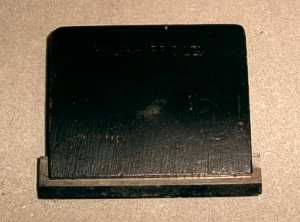 A sharp edged file or knife is required for scratching tubes when severing them. I use a
knife made by Philip Harris Ltd.
A sharp edged file or knife is required for scratching tubes when severing them. I use a
knife made by Philip Harris Ltd.
Graphite Cones
Graphite is highly heat resistant. Graphite cones are useful for flaring out the ends of
tubes. The flat ends of the cones can also be used for flattening and shaping hot glass.
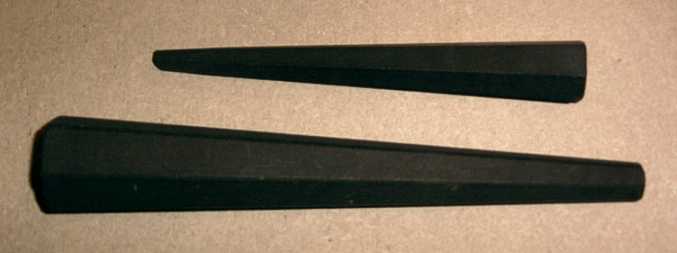
Annealing Tin
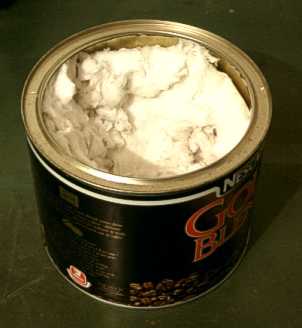 I use a 500g coffee tin lined with ceramic fibre wool. Hot glass parts can be placed in
the tin and covered with ceramic wool where they are protected from draughts and allowed
to cool slowly.
I use a 500g coffee tin lined with ceramic fibre wool. Hot glass parts can be placed in
the tin and covered with ceramic wool where they are protected from draughts and allowed
to cool slowly.
Ceramic fibre wool can be obtained from
RS (stock number 299-3695). It can withstand temperatures up to 1160C. This material
must be kept in a clearly labeled container because it has the same appearance as cotton
wool, but can cause eye, skin and respiratory irritation.
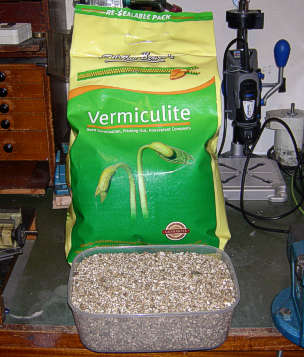 Note added July 2009:
Note added July 2009:
I have since discovered that Vermiculite is better than glass wool
for annealing in all respects. Vermiculite is available in large bags from garden centres
and is very cheap. It is normally used for seed germination and houseplant composts.
It is a naturally occurring mineral and is non-toxic. The only caution is to buy new
Vermiculite. Apparently, some old (pre 1990s) Vermiculite is contaminated with
asbestos.
The glass item is heated uniformly and then buried 10cm deep in Vermiculite. It is then
left to cool slowly.
Wire
Glass to metal seal wire can be scavenged from old lamps and vacuum tubes, but it is
often much easier to work with sensible lengths of wire purchased from a specialist
materials supplier. Ni48/Fe52 wire, which is suitable for use with soda-lime glass can
be purchased in small quantities from Goodfellow.
Tungsten wire can be used for making lamps and electron devices. For lamps, I use 0.025mm
diameter tungsten wire supplied by
Goodfellow.
Pumping Equipment
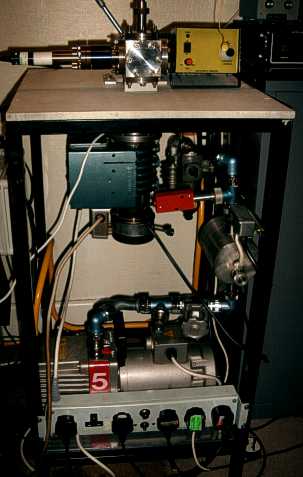 Some form of vacuum pump is required if vacuum devices are to be made. A two stage rotary
pump is sufficient for many things such as glow tubes, filament lamps and radiometers. I
use an Edwards E2M5 rotary pump (the unit at the bottom of the rig, with the '5' on it),
which has an ultimate pressure of 1x10-3mBar.
Some form of vacuum pump is required if vacuum devices are to be made. A two stage rotary
pump is sufficient for many things such as glow tubes, filament lamps and radiometers. I
use an Edwards E2M5 rotary pump (the unit at the bottom of the rig, with the '5' on it),
which has an ultimate pressure of 1x10-3mBar.
When making thermionic devices, an oil diffusion pump or some other form of high vacuum
pump is required. I use an air cooled Edwards oil diffusion pump (the large blue unit,
hanging above the rotary pump).
The stainless steel cylinder on the right hand side is a foreline trap containing activated
alumina. It absorbs oil vapor from the rotary pump to prevent it entering the high vacuum
system. The trap also contains a heater which can be used to drive the moisture out of a
new alumina charge.
The red box near the middle of the picture is a Pirani gauge head for measuring the backing
/ roughing pressure. The cylinder at the very top left of the picture is a high temperature
Penning gauge head which can measure down to 10-10mBar.
I have made the top of the rig from Syndanio board. All the pipe-work and gauge heads above
this board are capable of operating at high temperature. CF flanges are used, which seal
using copper gaskets. The plan is that when I make thermionic devices I can heat the whole
of the top section of the vacuum rig to de-gas it. I should then be able to obtain a better
vacuum.
 I decided to start learning using soda-lime glass because it is cheap and has a lower
softening temperature than borosilicate glass. Common soda-lime glass softens at around
600C. I have learned that soda-lime glass has a high expansion co-efficient, which makes
if very susceptible to cracking. However, with a little care and hand annealing, much
can be accomplished with it. Lead glass is easier to work with than soda-lime glass,
but is now virtually unavailable in the UK.It is best to buy new glass because it can
degrade in storage and become harder to work with.
I decided to start learning using soda-lime glass because it is cheap and has a lower
softening temperature than borosilicate glass. Common soda-lime glass softens at around
600C. I have learned that soda-lime glass has a high expansion co-efficient, which makes
if very susceptible to cracking. However, with a little care and hand annealing, much
can be accomplished with it. Lead glass is easier to work with than soda-lime glass,
but is now virtually unavailable in the UK.It is best to buy new glass because it can
degrade in storage and become harder to work with.

 A sharp edged file or knife is required for scratching tubes when severing them. I use a
knife made by Philip Harris Ltd.
A sharp edged file or knife is required for scratching tubes when severing them. I use a
knife made by Philip Harris Ltd.
 I use a 500g coffee tin lined with ceramic fibre wool. Hot glass parts can be placed in
the tin and covered with ceramic wool where they are protected from draughts and allowed
to cool slowly.
I use a 500g coffee tin lined with ceramic fibre wool. Hot glass parts can be placed in
the tin and covered with ceramic wool where they are protected from draughts and allowed
to cool slowly. Note added July 2009:
Note added July 2009: Some form of vacuum pump is required if vacuum devices are to be made. A two stage rotary
pump is sufficient for many things such as glow tubes, filament lamps and radiometers. I
use an Edwards E2M5 rotary pump (the unit at the bottom of the rig, with the '5' on it),
which has an ultimate pressure of 1x10-3mBar.
Some form of vacuum pump is required if vacuum devices are to be made. A two stage rotary
pump is sufficient for many things such as glow tubes, filament lamps and radiometers. I
use an Edwards E2M5 rotary pump (the unit at the bottom of the rig, with the '5' on it),
which has an ultimate pressure of 1x10-3mBar.